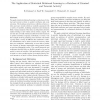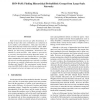28 search results - page 1 / 6 » Collaborative Mining in Multiple Social Networks Data for Cr... |
CSE
2009
IEEE
14 years 4 months ago
2009
IEEE
—The hidden knowledge in social networks data can be regarded as an important resource for criminal investigations which can help finding the structure and organization of a crim...
SAC
2011
ACM
13 years 6 days ago
2011
ACM
In many criminal cases, forensically collected data contain valuable information about a suspect’s social networks. An investigator often has to manually extract information fro...
SDM
2010
SIAM
13 years 10 months ago
2010
SIAM
We apply statistical relational learning to a database of criminal and terrorist activity to predict attributes and event outcomes. The database stems from a collection of news ar...
EUROISI
2008
13 years 11 months ago
2008
The tragic events of September 11th have caused drastic effects on many aspects of society. Academics in the fields of computational and information science have been called upon ...
ICDM
2007
IEEE
14 years 3 months ago
2007
IEEE
Real-world social networks are often hierarchical, reflecting the fact that some communities are composed of a few smaller, sub-communities. This paper describes a hierarchical B...


